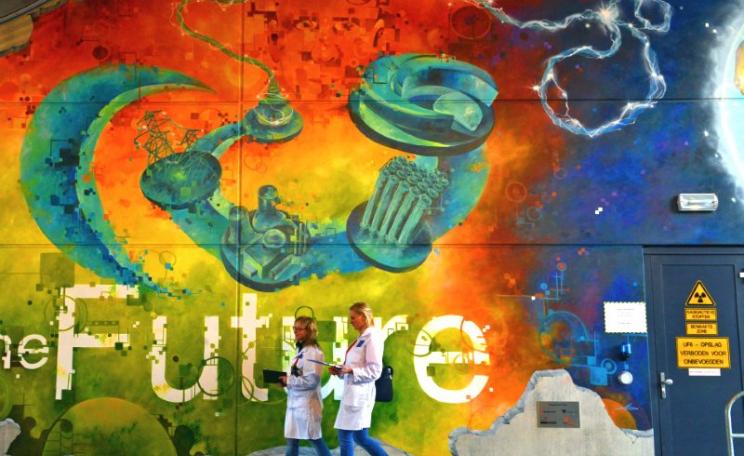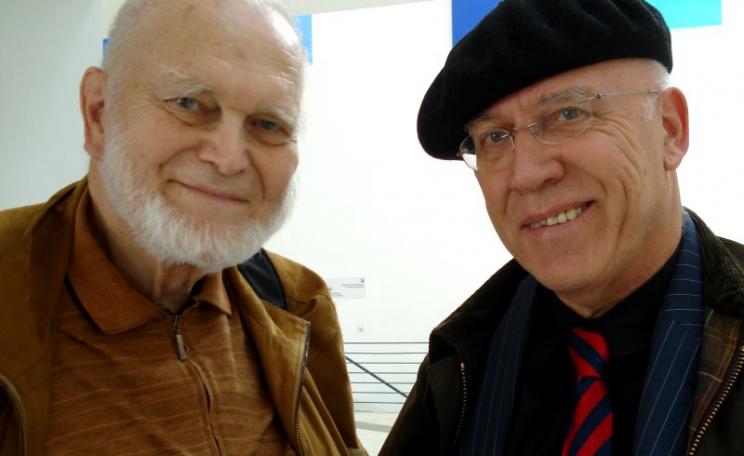The hot particle scenario at Sellafield beach is the same as in the inner Chernobyl contamination zones. The radiation dose rate is about the same as the 30km zone of the Fukushima reactors shortly after the disaster.
I am angry to the depths of my soul that the earth has been so injured while we were all bemused by supposed monuments of value and intellect, vaults of bogus cultural riches... Sellafield, which pours waste plutonium into the world's natural environment, and bomb grade plutonium into the world's political environment. For money.
So wrote US author Marilynne Robinson in Mother Country in 1989, a few years after the 1983 discovery by Yorkshire TV (video embed below) of the child leukemia excess (ten times the expected number) at Seascale, a village next to the Sellafield nuclear site.
In the documentary, presented by a young David Dimbleby, we see the evidence and a debate between Professor Ed Radford (who started me out on my radiation enquiry in 1991) and a young Wilks on one side, and two men from British Nuclear Fuels.
Despite the Black Inquiry [1], a court case (Reay and Hope vs BNFL), several reports from the National Radiological Protection Board NRPB and their Alice in Wonderland Mirror, COMARE, no one pointed out that the science behind all the protestations of innocence is bogus.
The court case was lost for the same reason. Martyn Day the solicitor was advised to use the fathers' exposures and genetic risk as a strategy - a mistake that cost them the case. It was the direct exposures from the beaches that were the cause of the child leukemias, not the fathers.
So all BNFL had to do to win, was to show that there were leukemia children whose fathers did not work at Sellafield. Which there were.
There is no single measure of 'radiation'
The essential problem was that everyone assumed that there was a valid scientific way of measuring radiation which applied equally to all kinds of exposure, and that it produced a number, called the 'dose' which could be used to quantify biological damage (and therefore child leukemia).
BNFL argued that the fact that there was a lot of plutonium on the beach and in the houses at Seascale was not enough. To get enough 'dose' from plutonium, the children would have had to eat some kilograms of house dust. Accepting this nonsense, the late Prof Gardner (and the court case) attempted to get around this by arguing that it was a genetic effect delivered by the fathers' sperm.
A mistake, as I wrote to Martyn Day at the time, and also to Gardner. But Gardner (aged 50, not a smoker) went into hospital with lung cancer just after I sent my letter, and never came out.
The 1984 Black Inquiry was less easily fooled. Sir Douglas Black recommended two new independent outfits to investigate the problem. They were the Small Area Health Statistics Unit (SAHSU) and the Committee on Medical Aspects of Radiation in the Environment, (COMARE).
The hot particle scenario at Sellafield beach is the same as in the inner Chernobyl contamination zones. The radiation dose rate is about the same as the 30km zone of the Fukushima reactors shortly after the disaster.
COMARE was quickly infiltrated by the nuclear industry faithful, and produced one biased report after another exonerating Sellafield as a cause of the child cancers. It used the same 'dose' argument as BNFL in the documentary, as did NRPB's evidence to Sir Douglas.
Initially COMARE toyed with the idea of population mixing and an unknown virus as the cause, but conceded there was no population mixing at Sellafield. However, its latest 17th Report, published last year, finally gave way and decided that it was population mixing after all.
Contamination of the seashore? What contamination?
This seashore contamination has, since 1983, spread to the coast of north Wales where it is measured and where there was a 18-fold child cancer excess by 2004, and to Carlingford in Ireland (see Wolves of Water, Busby 2007) with similar effects.
Well, what is the fuss about? What should the locals and holidaymakers be afraid of?
Video: 'Windscale - The Nuclear Laundry', first broadcast on Yorkshire TV, 1st November 1983.
I was sent a scanning electron microscope (SEM) photograph by Cumbrians Opposed to a Radioactive Environment (CORE) the local anti-nuclear NGO. A sample from the tidal estuary of the river Esk near a popular coastal path collected on 12th March 2015. I was asked to comment. I show the SEM picture in Figure 1 (above right).
It was collected by CORE for Arnie Gundersen during his brief visit to Cumbria and given to Dr Marco Kaltofen from Boston MA, USA who measures particles. Marco told me on the phone that there were many such particles found in this mud sample. His machine also uses X-ray fluorescence, and can identify the elemental composition of any particle. The XRF spectrum is inset. It shows that the particle is made from Plutonium and Americium.
I knew already that the mud in that area was highly contaminated with plutonium. CORE had sent me samples in the 1990s which I still have and which I use to calibrate my gamma spectrometers. One of those had 22,000 Bq/kg Plutonium-239 together with about the same amount of Cs-137 and a host of other nasty isotopes.
Killer isotope of the future: Americium 241
But this is the first time I had seen the villain of the piece, the hot particle. You need some fancy gear for that. Plutonium-241 is a major effluent from Sellafield, a beta emitter with a half-life of just 14 years turning into the alpha emitter Americium-241 with a half-life of 432 years.
For this reason, the concentration of the Am-241 in the Irish Sea sediments is increasing, even if they shut the pipeline tomorrow. Waves of this material reached the Irish coast in the late 1990s and by now has contaminated the beaches near Dublin and will soon (or may have already) reached Waterford. It has been along the coast of Wales since the 1980s, building up in the Menai and on a big tidal sediment bank called the Lavan Sands.
Marco used gamma spectrometry to show that the bulk sample had a radioactivity of 390 kBq/kg (390,000) with signals from Caesium-137 and Americium 241. A Becquerel is one disintegration per second. One click on a Geiger counter.
So what about the individual particles? The one in the picture is about 50 microns diameter. Marco says the XRF suggests about 50% Americium and perhaps 20% Plutonium. I can use these figures to calculate that the activity of the particle itself is about 150,000 Bq of alpha radiation and about 500,000 Bq of beta radiation.
This is a single particle of diameter slightly smaller than the average human hair, invisible to the naked eye. Such a particle is easily resuspended in the air by wind, and indeed will automatically fly itself into the air as a result of the electrostatic charge it builds up as it emits charge in the form of beta and alpha radiation.
That such material is brought ashore over kilometre distances by 'sea-to-land' transfer was discovered by scientists from Harwell in the 1980s. Plutonium from Sellafield has been measured in childrens' teeth right across England [2].
Radiation levels on Sellafield beach 50 times inland levels
We can get some idea of the general level of contamination here. CORE have a Geiger counter which they have used for a long time to astound journalists, school parties, students and campaigners. The meter jumps from a background inland of 5 to 10 to 200 to 300 counts per Second in the area where the sample was taken.
This equates to a dose rate of about 3 microSieverts per hour (uSv/h) over the contamination. That fits reasonably well with Marco's result for the bulk sample. Prof Imanaka from Kyoto University visited the area in 2014 and took some samples back to Japan: he found Cs-137 and Americium-241, but at lower levels, around 1,000 Bq/kg.
In passing, there are some odd results in the official data, the annual Ministry of Agriculture and Fisheries RIFE reports. They seem to be misreporting the dose rates over the contamination. In the latest 2015 report we see 500 Bq/kg of Cs-137 and 1,200 Bq/kg Am-241. If we assume a depth of 50cm, this translates into a surface activity of about 400 kBq/m2, which is roughly what Prof Sanderson found in his 1990 aerial gamma survey.
It is technically straightforward [3] to turn this surface contamination into a gamma dose rate at 1 metre above the ground. We get 1.9 uSv/h. So this roughly agrees with CORE since my calculation is only for the Cs-137. But RIFE reports around 0.1 to 0.2 uSv/h.
Perhaps they took their gamma readings at high tide? Reducing measurements by 90%
So although RIFE contamination levels agree with the independent measurements, the official dose rates (including Prof Sanderson's) are about 10 to 20 times too low. Of course, at estuary high tide, all this gamma activity is covered by water and the dose rate will fall by a factor of 10. Maybe RIFE only get out their gear when the water has covered up the contamination?
What do all these numbers mean to the non-scientist? Well, the Geiger counter dose rate of 3 uSv/h tells us that the area contamination is about 900 kBq/m2 in that tidal area of the River Esk. The particle analysis tells us that the radioactivity is mainly in Plutonium and Americium hot particles with some Caesium-137.
This hot particle scenario is the same as in the inner Chernobyl contamination zones. The dose rate is about equal to the level of contamination in the 30km zone of the Fukushima reactors shortly after the disaster.
Recently, BBC reporter Rupert Wingfield Hayes measured 3 uSv/h in the Fukushima exclusion zone; the clip being where radiation expert Geraldine 'Gerry' Thomas made her classic arithmetical gaffe.
The United Nations developed a contamination classification scheme after Chernobyl. Its definition of contaminated land was 37-185 kBq/m2. The Chernobyl Zone of Permanent Control was set at 185-555 kBq/m2 [4]. So we can say that the estuary is 'radioactively contaminated land' and should be a 'zone of permanent control' under the United Nations definition.
Suppressing the inconvenient truth
A number of questions arise in the mind of the man on the Clapham Omnibus.
First, how is it that it took a TV company to draw attention to the dead bodies of the children, rather than the health authority?
Second, how is it that it takes the investigation of a sample obtained by ordinary people and a helpful scientist in America to show a picture of what there is in the sand and mud down there? Why wasn't this done by COMARE, NRPB, BNFL, Harwell, and so forth?
Third, how is it that none of the authorities there have measured the radioactivity and the particles and fenced it all off?
This would have happened in the Soviet Union; it would happen in the USA. CORE have consistently complained to the local authorities and the Sellafield Environmental Health watchdog Group about these contaminations, but have been ever ignored or fobbed off. They tell me that one Sellafield PR response was that it did not matter as people usually wore gumboots.
Finally, how is it that no one connected the hot particles with the childhood cancers and calculated the huge doses that even one of these particles, inhaled and internalised, would deliver to local tissue in organs of the body?
Well the answer is simple. It is that the nuclear military complex, lobby, mafia, however you describe it, it is powerful and real, and continues to keep a death grip on the scientific picture of radiation and health. And COMARE, like the other 'independent' scientific agencies and committees that provide the governmental theatricals, are populated with idiots, placemen and dodgy characters.
COMARE was intended by Sir Douglas Black, at the Seascale Inquiry, to provide investigative research independent from NRPB. But they share the same site at UK Atomic Energy Research Harwell. One of the first secretaries, John Cooper, went on to become Director of NRPB, now called Public Health England, though he disappeared rapidly when the German sea-dumping documentary caught him out on TV (below).
Death in a grain of dust
On COMARE there's Richard Wakeford, ex BNFL. And there's Frank de Vocht, who writes for Sense about Science and attacks all my published papers.
SAHSU, the epidemiological wing of this cover-up (now known in epidemiology circles as the 'cluster-busters') is no better: it spent its energy (and government money) developing epidemiological tools to prove the childhood leukemia clusters like Seascale, were due to random chance. I wrote a poem about this in 2003 entitled 'Paul Elliott' after its Director.
At Sellafield, along that coast,
Out of the corner of your eye
You'll maybe see a little ghost
A girl who didn't have to die
If you're lucky, you may see her dance
Sadly along that altered shore
It's certain she's only there by chance
That's what I'm told: I can't say more.
So let's look at the overall picture. Sticking with poetry, TS Eliot's line, "I will show you fear in a handful of dust" seems the most appropriate summary. Only it's worse: death on Sellafield beach is lurking in a single grain of dust so tiny as to be invisible, yet spitting out 650,000 alpha and beta particles every second.
And Sellafield, the largest legitimized source of radioactive pollution in the world, has turned that beautiful coast into Eliot's Waste Land.
But there are no United Nations warning notices at the beaches and estuaries near Sellafield.
The areas should be fenced off. The coastal villages must be evacuated.
Chris Busby is an expert on the health effects of ionizing radiation. He qualified in Chemical Physics at the Universities of London and Kent, and worked on the molecular physical chemistry of living cells for the Wellcome Foundation. Professor Busby is the Scientific Secretary of the European Committee on Radiation Risk based in Brussels and has edited many of its publications since its founding in 1998. He has held a number of honorary University positions, including Visiting Professor in the Faculty of Health of the University of Ulster. Busby currently lives in Riga, Latvia. See also: chrisbusbyexposed.org, greenaudit.org and llrc.org.
References
1. Black D. Report of the Independent Advisory Group. Chairman: Sir Douglas Black. HMSO: London; 1984. Investigation of the Possible Increased Incidence of Cancer in West Cumbria.
2. Busby C (2007) Wolves of Water. A Study constructed from Atomic radiation, Morality, Epidemiology, Science, Bias, Philosophy and Death. Aberystwyth: Green Audit. Available from Amazon UK.
3. Handbook of Radiological Protection. London HMSO 1972
4. Savchenko VK (1995) The Ecology of the Chernobyl Catastrophe. Paris: UNESCO p11.







